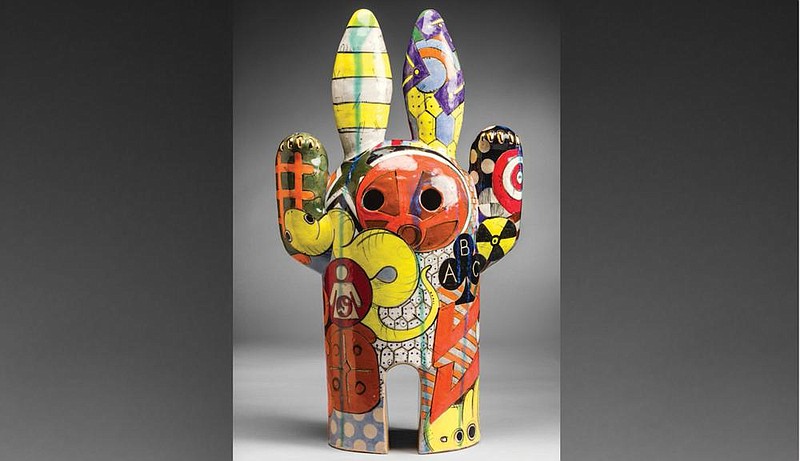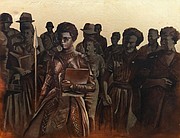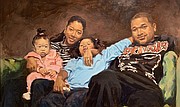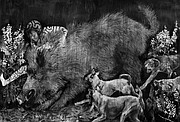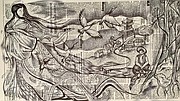“The 62nd Annual Delta Exhibition”
When: Friday-Aug. 23
Who: Organized by the Arkansas Arts Center in collaboration with Historic Arkansas Museum,Thea Foundation, Acansa Gallery and the Argenta Branch of the William F. Laman Library
Information: (501) 372-4000, arkansasartscenter.org/delta
The exhibition is supported by Mrs. Lisenne Rockefeller, Terri and Chuck Erwin, Judy Fletcher, in memory of John R. Fletcher; Friday, Eldredge & Clark, LLP; JC Thompson Trust; Dianne and Bobby Tucker; AAC Contemporaries; Bank OZK; Phyllis and Michael Barrier; East Harding Construction; Marion W. Fulk; Barbara House; Don Tilton. The Grand Award is supported by The John William Linn Endowment Fund; the exhibition is supported by the Andre Simon Memorial Trust in memory of everyone who has died of AIDS.
The Arkansas Arts Center’s “62nd Annual Delta Exhibition” was already one for the history books.
Because the Arts Center’s new building is under construction and not opening until 2022, the museum planned to spread its exhibition across four other venues — Historic Arkansas Museum in Little Rock and the THEA Foundation, Acansa Gallery and the Argenta Branch of the William F. Laman Library in North Little Rock.
Then came the covid-19 pandemic and, on April 21, the Arts Center announced the annual exhibit of contemporary art from Arkansas and its border states would be transformed into a virtual exhibition.
Despite yet another challenge, the Arts Center was determined that the Delta would continue.
“Offering the Delta Exhibition in a digital format opens a new world of opportunity for the Arkansas Arts Center,” says Victoria Ramirez, executive director of the museum. Recognizing the exhibition as “an integral piece” of the museum’s legacy, she says part of the institution’s responsibility is “to share our collection with the broadest public as possible.
“Practically speaking, the online exhibition is readily accessible to more people and will introduce a broader audience to the artists of the Delta.”
“It’s still great and extremely important that the Delta Exhibition is continuing this year and being held online,” said Las Vegas-based artist Wade Hampton, who has work in this year’s Delta and an exhibition at Hearne Fine Art through July 4.
The Arts Center’s members’ preview, which begins at 6 p.m. Thursday, will feature an online conversation between guest juror Stefanie Fedor, executive director of the Visual Arts Center in Richmond, Va., and Brian Lang, chief curator and Windgate Foundation curator of contemporary craft at the Arkansas Arts Center. They will talk about the art selection process. After the conversation, Fedor will reveal the Grand Award winner ($2,500), two Delta Award winners ($750 each) and the Contemporaries Award winner ($250). This online event is open only to museum members, the artists and invited guests.
Fedor and Lang’s talk will be posted later on the Arts Center’s YouTube channel.
The online exhibition opens at 10 a.m. Friday at arkansasartscenter.org/delta .
THE DIGITAL DELTA
Fedor selected 63 works from 772 entries by 348 artists. She examines the works on a computer; the images are presented with titles, sizes, medium, but no names.
A strong point of view is the first thing she looks for, she says, along with mastery in the artist’s work, technical ability and whether the work can stand alone as a strong solo work.
“I reviewed the works after the decision was made that this exhibition would have to live online, and I took that additionally into consideration. Although, I don’t think my selections would have been that much different otherwise. I would have loved to have seen them displayed in person.”
Fedor and Ramirez see the digital realm as an opportunity to expand the public’s access to art.
“There is definitely the opportunity for wider reach,” Fedor says. “There is a lot of extra work for our marketing and public relations departments to push online exhibitions out further, beyond our regular in-person audience. But we have a lot to learn about how to make this experience dialogic, so viewers can offer feedback.”
“We will be launching a new website in 2021 that will be a real game-changer for us,” Ramirez says. “It will allow us to feature more of the collection online and consider innovative ways technology can help people better understand and engage with the art. We also have an app we will be launching soon which features works from the Arts Center’s collection.
“With 14,000 works from the Delta and all over the world in our collection, the possibilities are endless.”
Lang says the original plan for the Delta was to have works at each of the four venues based on their scale and visual harmony.
“When we made the decision to move to a digital format, we began building one comprehensive gallery that would allow visitors to view all the works on one page.”
Lang says each of the four partner organizations has curated its own theme-based exhibit drawing upon the 63 works in the exhibition.
“The theme for Historic Arkansas Museum is ‘Arkansawyers,’ which explores the state’s quirky charm, unique experiences and diverse people who contribute to the cultural richness …” The idea, Lang says, was to create an “engaging and compelling way to call attention to each of our collaborating partners and the important work they do.”
Those four theme exhibits will also be available at the Arts Center’s Delta Exhibition website.
Angel Galloway, the Arts Center’s director of marketing and communication, says the museum researched gallery platforms “with interactive functionality allowing works to be searchable by multiple keywords and viewed in a variety of self-directed ways.”
“This year’s exhibition is uniquely interpreted and will be experienced by an online audience that can span the globe,” Galloway says.
SOMETHING LOST, GAINED
Seeing a work of art online or in a book is a different experience from seeing it in person, museum professionals and artists say.
“Is one’s experience with a work of art lessened if they view it on their mobile phone or reproduced in a postcard form?” Ramirez asks. “Certainly, there’s no comparison to experiencing the original work of art. Art is visceral and in nearly every way — physical, emotional, sensory — we gather more about art when we view the original in person.”
Little Rock artist Elizabeth Weber agrees. This is her first time to be accepted into the Delta, for Social Distancing, a sculpture of leaf skeletons, honey locust thorns, wool roving and “dandelion wishes.”
“I am honored to be a part of this prestigious event, but a not small part of me is a little disappointed that my sculpture will not be seen in the round,” she says. “That someone can’t walk up to it, peer inside the fragile, egg-like cavity to see the dandelion wishes nestled against the raw wool roving, notice how the light seeps through the delicate bleached leaf skeletons to illuminate the inside; to ponder the juxtaposition of such a thing nestled and resting on the sharp honey locust thorns and relate it to their own personal experiences.”
And while Weber has seen art online that resonates with her, she says, “I have never felt touched deep in my soul from a computer image.”
For Hampton there’s nothing better than seeing art in person, “witnessing people’s reaction and meeting other artists.”
But a digital presentation, he says, “may cause the viewer to pay attention to the narrative of that particular work and to the determination of the organization and the artists that are not giving way to any reasons in order for the art to be seen and appreciated.”
Pastel artist Cynthia Kresse of Eureka Springs says she will miss seeing all of the art and the artists in person as she would have at a regular museum opening.
“An online exhibit, with a formal opening, and the judge’s comments presented to everyone simultaneously, is an acceptable solution.”
But Kresse believes the art loses something online:
“The colors in my work have a subtle interplay, and the edges are soft. The camera may simplify the underlying color work and some of the softer details may be lost. My photographer and I work carefully to get it as correct as possible, but it is still a photograph of a pastel, not a pastel.”
Little Rock native and Brooklyn resident Ajamu Kojo takes the words of martial artist/film star Bruce Lee to heart.
“He once said, ‘Be like water.’ Water adapts to its environment. Art is to be seen and touched to fully experience all that it has to offer. You cannot understand what your favorite bakery smells like by looking at a photograph. However, we are dealing with a pandemic. So, until then …”
Kojo sees an upside to the digital approach.
“It places us in the unique position of getting to know the human that created the work. What’s the artist’s philosophy? Why do they create the work they do? What are their goals as an artist? What do they want and what do you want out of this art form? What is the legacy the artist intends on leaving behind? And how will that legacy add to the betterment of society?”
Virtual events
Virtual events for a virtual exhibition:
As part of “The 62nd Annual Delta Exhibition,” the Arkansas Arts Center will offer virtual studio visits and conversations with artists timed to coincide with Little Rock’s 2nd Friday Art Night and North Little Rock’s 3rd Friday Art Walks. These programs will also feature representatives from the exhibition’s partners Historic Arkansas Museum, Thea Foundation, Acansa Gallery and the Argenta Branch of the William F. Laman Library.
The talks and tours will be online via the Zoom platform. Registration will be available at arkansasartscenteAnais Dasse's Hog Hunting is a charcoal, graphite and oil on gessoed paper, It is 48 x 77 inches in size. (Courtesy of the Arkansas Arts Center)
vir.org/delta . All these events are free.
Noon June 23 — Ajamu Kojo, a Little Rock native living in Brooklyn, will discuss his working methods, how the Arkansas Arts Center was a space of inspiration for him and what it is like to be a working artist in New York. A question-and-answer session follows.
Noon June 30 — A talk and studio tour with Conway artist Barbara Satterfield. A question-and-answer session follows.
Noon, July 21 — Little Rock artist Joel Boyd will talk about his background, artistic inspiration and methods with the Arkansas Arts Center’s education director, Rana Edgar. A question-and-answer session follows.
Noon, July 28 — Joe Morzuch of Starkville, Miss., will discuss his art and offer a tour of his studio. A question-and-answer session follows.
Noon Aug. 4 — Louis Watts of Burlington, Vt., talks about his artwork and influences with Brian J. Lang, the Arts Center’s chief curator and Windgate Foundation curator of contemporary craft. A question-and-answer session follows.
Noon Aug. 18 — Kayla O’Neal of Shongaloo, La., and Sharon Havelka of Memphis talk about their art with Lang. A question-and-answer session follows.
— Ellis Widner
